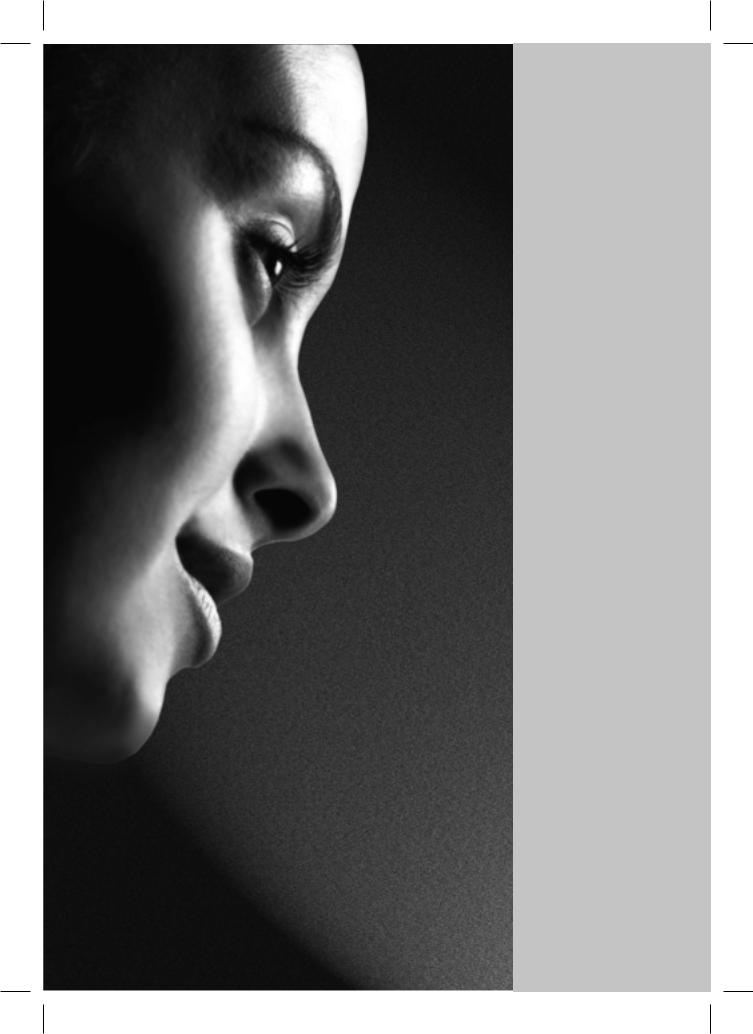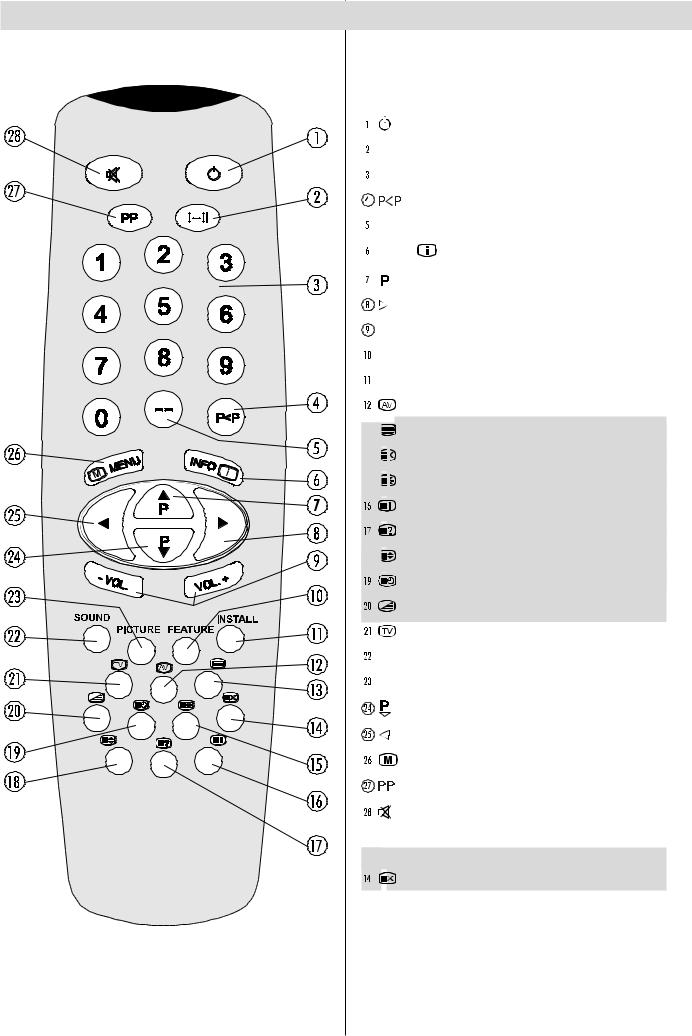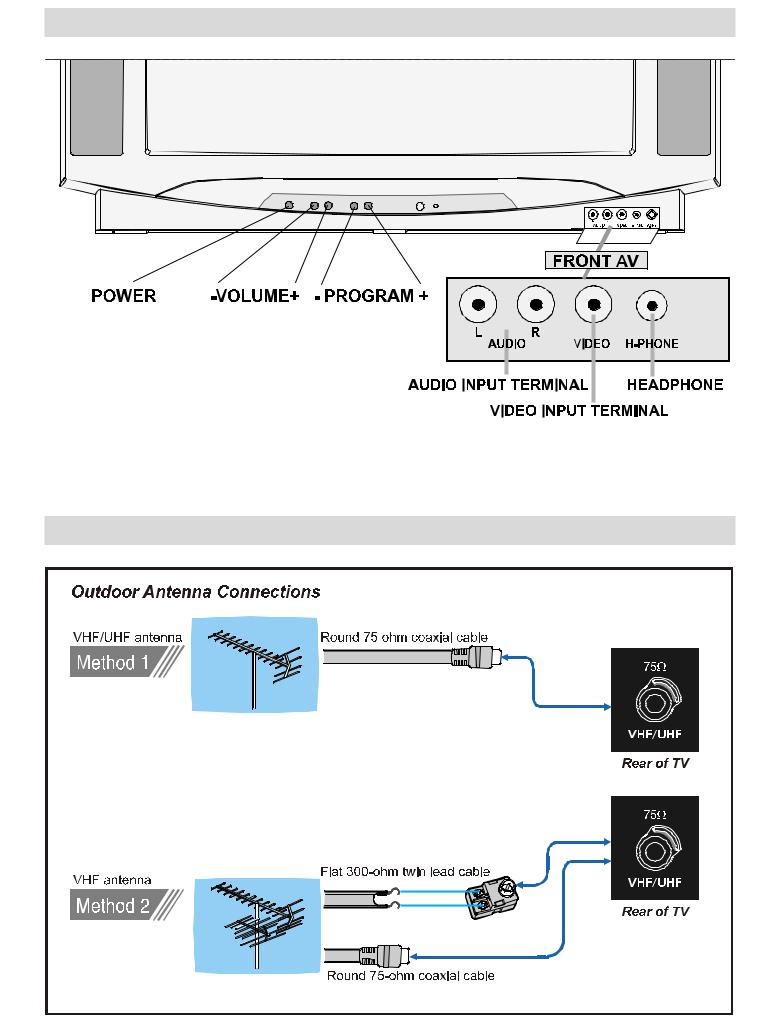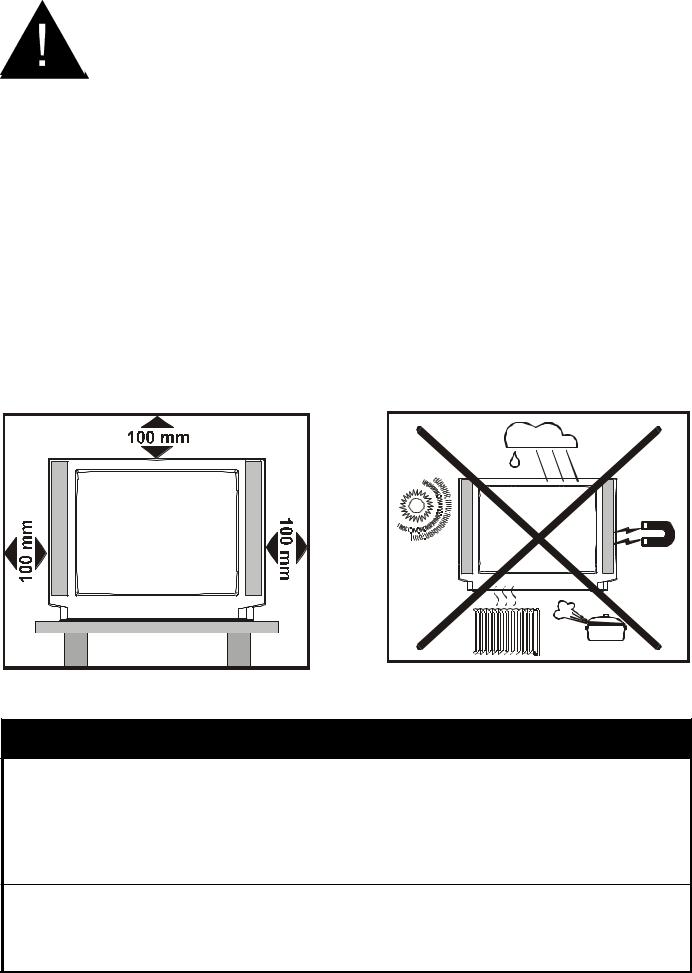Toshiba 28N13B, 28N13D, 28N13D2 Owner Manual

Color profile: Disabled
Composite Default screen
TOSHIBA
The power to open people’s eyes
28N13B/D/D2
Colour Television
Owners Manual
Murat URUSAKLI-- mailto:murat.urusakli@vestel.com.tr 20 Kas m 2001 Sal 14:13:04

Contents |
|
Remote Control Buttons ................................... |
2 |
Control Panel Buttons....................................... |
3 |
Antenna Connections ........................................ |
3 |
Preparation ......................................................... |
4 |
Features ........................................................... |
4 |
For your safety ................................................... |
4 |
Before Switching on your TV ........................... |
6 |
Power connection ............................................. |
6 |
Aerial Connections ........................................... |
6 |
How to connect other devices .......................... |
6 |
Inserting batteries in the remote control |
|
handset ............................................................. |
6 |
Switching the TV ON/OFF ................................. |
6 |
Operating the TV ............................................... |
6 |
APS (Automatic Programming System) ........... |
6 |
Operating with the onset buttons ...................... |
7 |
Operating with Remote Control ........................ |
7 |
Menu System ...................................................... |
7 |
Information Menu .............................................. |
8 |
Sound Menu ....................................................... |
8 |
To change sound settings ................................. |
8 |
Setting Volume: ................................................. |
8 |
Setting Bass Level: ........................................... |
8 |
Setting Treble Level: ......................................... |
8 |
Setting Balance: ............................................... |
8 |
Setting Sound Effect: ........................................ |
8 |
To Store the Settings:........................................ |
9 |
To Change Headphone Sound Settings: ........... |
9 |
Setting Headphone Volume: ............................. |
9 |
Setting Headphone Sound Mode: ..................... |
9 |
To Store the Settings:........................................ |
9 |
Picture Menu ...................................................... |
9 |
To change picture settings: ............................... |
9 |
Setting Brightness: ........................................... |
9 |
Setting Colour: .................................................. |
9 |
Setting Contrast: .............................................. |
9 |
Setting Sharpness: ........................................... |
9 |
Setting Hue : ..................................................... |
9 |
Picture Mode Menu: ........................................ |
10 |
To Store the Settings:...................................... |
10 |
Feature Menu ................................................... |
10 |
Sleep Timer: ................................................... |
10 |
Child Lock: ...................................................... |
10 |
Installation Menu ............................................. |
10 |
Tuning Menu ................................................... |
10 |
Automatic Search ........................................... |
11 |
To name a Programme................................... |
11 |
To change Standard ........................................ |
11 |
Direct Channel Access ................................... |
11 |
Fine Tuning ..................................................... |
11 |
PROGRAM. (Programming) Menu ................. |
11 |
APS (Automatic Programming System): 12 |
|
TV Config. Menu .............................................. |
12 |
Selecting Menu Language .............................. |
12 |
Selecting Country ........................................... |
13 |
Setting External Source Output ...................... |
13 |
Other Features................................................. |
13 |
Personal Preference ...................................... |
13 |
Programme Swapping.................................... |
13 |
Sound Mute..................................................... |
13 |
Bilingual Broadcast ......................................... |
13 |
Information on Screen .................................... |
13 |
TELETEXT ........................................................ |
14 |
To operate Teletext .......................................... |
14 |
To select a page of Teletext ............................ |
14 |
To Select Index Page ...................................... |
14 |
To Select Teletext with a TV Programme ........ |
14 |
Searching for a Channel while watching TV ... |
14 |
To Select Double Height Text .......................... |
14 |
To Reveal “concealed” Information ................. |
14 |
To Stop Automatic Page Change .................... |
14 |
To Select a Subcode Page ............................. |
15 |
Fastext and Toptext ......................................... |
15 |
For Fastext and Toptext .................................. |
15 |
For TOPTEXT ................................................ |
15 |
To exit Teletext ................................................ |
15 |
To Display the Time ........................................ |
15 |
Connect Peripheral Equipment...................... |
16 |
Via the Euroconnector .................................... |
17 |
RGB mode ..................................................... |
17 |
Via Ant Input .................................................... |
17 |
Decoder .......................................................... |
17 |
TV and Video Recorder .................................. |
17 |
NTSC Playback .............................................. |
17 |
Copy Facility ................................................... |
17 |
Camera and Camcorder ................................ |
17 |
Connect the decoder to the video recorder .... |
17 |
Connecting Headphones ................................ |
18 |
Tips.................................................................... |
18 |
Specifications................................................... |
18 |
ENGLISH - 1 -

Remote Control Buttons

 = Stand By
= Stand By
 I-II = Mono/Stereo - Dual I-II
I-II = Mono/Stereo - Dual I-II
 0 - 9 = Direct Program
0 - 9 = Direct Program
=Previous Programme
 - - = Two Digit Program Number Entry
- - = Two Digit Program Number Entry
 INFO
INFO  = Info
= Info

 = Programme Up (Cursor Up)
= Programme Up (Cursor Up)
= Cursor Right
-VOL. / VOL. + = Volume - / Volume +
 Yellow (FEATURE) = Feature Menu
Yellow (FEATURE) = Feature Menu
 Blue (INSTALL) = Installation Menu
Blue (INSTALL) = Installation Menu

 = External Source (AV1, AV2, AV3, RGB)
= External Source (AV1, AV2, AV3, RGB)

 = Teletext
= Teletext

 = Update
= Update

 = Hold
= Hold

 = Index Page
= Index Page

 = Reveal
= Reveal

 = Expand
= Expand

 = Time
= Time

 = Mix
= Mix

 = TV / Quit Menu
= TV / Quit Menu
 Red (SOUND) = Sound Menu
Red (SOUND) = Sound Menu
 Green (PICTURE) = Picture Menu
Green (PICTURE) = Picture Menu
= Programme Down (Cursor Down)
= Cursor Left

 MENU = Menu
MENU = Menu
= Recall Personal Preference

 = Mute
= Mute
PICTURE MODE CHANGE BUTTON

 = Auto / 4:3 / 16:9 / Cinema
= Auto / 4:3 / 16:9 / Cinema
ENGLISH - 2 -

Control Panel Buttons
Antenna Connections
ENGLISH - 3 -

Preparation
Place TV on a solid surface.
For ventilation, leave a space of at least 10 cm free all around the set. To prevent any fault and unsafe situations, please do not place any objects on top of the set.
Features
•It is a remote controlled color television.
•100 programmes from VHF, UHF bands or cable channels can be preset.
•It can tune cable channels.
•Controlling the TV is very easy by its menu driven system.
•It has Euroconnector socket for external devices (such as computer, video, video games, audio set, etc.)
•Second Euroconnector socket is available.
•Front AV input and Back AV output is available.
•Stereo sound systems (German or German+Nicam) are available.
•Full function Teletext (Fastext, Toptext).
•It is possible to connect headphone.
•Direct channel access.
•APS Plus (Automatic Programming System).
•All programmes can be named.
•Programme swapping between last watched two programmes.
•Forward or backward automatic tuning.
•Sleep timer.
•Automatic sound mute when no transmission.
•5 minutes after the broadcasting (closedown), the TV switches itself automatically to stand-by mode.
For your safety
This equipment has been designed and manufactured to meet international safety standards but, like any electrical equipment, care must be taken if you are to obtain the best results and safety is to be assured. So, please read the points below for your own safety. They are of a general nature, intended to help you with all your electronic consumer products and some points may not apply to the goods you have just purchased.
Some “DOs” and “DON’Ts” for you
Air Circulation…
Leave at least 10cm clearance around the television to allow adequate ventilation. This will prevent the TV from overheating and consequential possible damage to the TV. Dusty places should also be avoided.
Heat Damage…
Damage may occur if you leave the TV in direct sunlight or near a heater. Avoid places subject to extremely high temperatures or humidity, or locations where the temperature is likely to fall below 5ºC (41ºF).
Mains Supply…
The mains supply required for this equipment is 230v AC 50Hz. Never connect to a DC supply or any other power source. DO ensure that the TV is not standing on the mains lead. DO NOT cut off the mains plug from this equipment, this incorporates a special Radio Interference Filter, the removal of which will impair its performance.
IF IN DOUBT PLEASE CONSULT A COMPETENT ELECTRICIAN.
DO…
DO read the operating instructions before you attempt to use the equipment.
DO ensure that all electrical connections (including the mains plug, extension leads and inter-connections between pieces of equipment) are properly made and in accordance with the manufacturers’ instructions.
Switch off and withdraw the mains plug before making or changing connections.
ENGLISH - 4 -

DO consult your dealer if you are ever in doubt about the installation, operation or safety of your equipment. DO be careful with glass panels or doors on equipment.
DO NOT…
DON’T remove any fixed cover as this may expose dangerous voltages.
DON’T obstruct the ventilation openings of the equipment with items such as newspapers, table-cloths, curtains etc. Overheating will cause damage and shorten the life of the equipment.
DON’T allow electrical equipment to be exposed to dripping or splashing or objects filled with liquids, such as vases, to be placed on the equipment.
DON’T place hot objects or naked flame sources, such as lighted candles or nightlights on, or close to the equipment. High temperatures can melt plastic and lead to fires.
DON’T use makeshift stands and NEVER fix legs with wood screws. To ensure complete safety, always fit the manufacturer’s approved stand or legs with the fixings provided according to the instructions.
DON’T listen to headphones at high volume, as such use can permanently damage your hearing.
DON’T leave equipment switched on when it is unattended, unless it is specifically stated that it is designed for unattended operation or has a standby mode. Switch off using the switch on the equipment and make sure your family know how to do this. Special arrangements may need to be made for infirm or
handicapped people.
DON’T continue to operate the equipment if you are in any doubt about it working normally, or it is damaged in any way – switch off, withdraw the mains plug and consult your dealer.
ABOVE ALL – NEVER let anyone, especially children, push anything into holes, slots or any other openings in the case – this could result in a fatal electric shock.
NEVER guess or take chances with electrical equipment of any kind – it is better to be safe than sorry.
CAUTION
RISK OF ELECTRIC SHOCK
The lightning flash with arrowhead symbol, within an equilateral triangle, is intended to alert the user to the presence of uninsulated "dangerous voltage" within the product's enclosure that may be of sufficient magnitude to constitute a risk of electric shock of persons.
The exclamation point within an equilateral triangle is intended to alert the user to the presence of important operating and maintenance (servicing) instructions in the literature accompanying the appliance.
ENGLISH - 5 -
